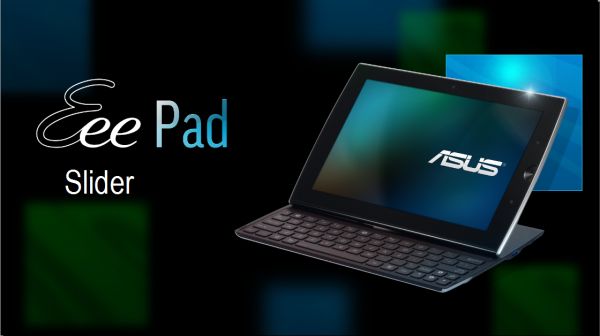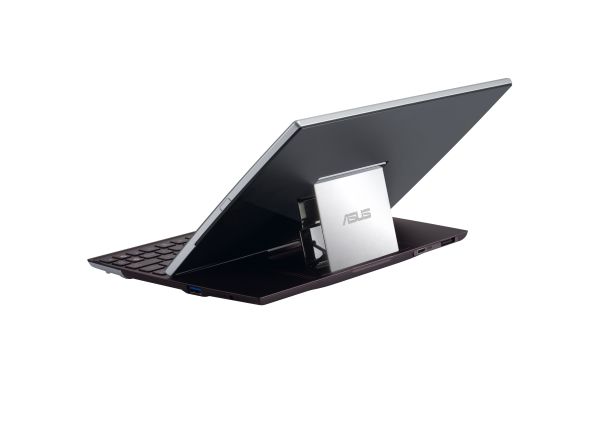ASUS Announces Eee Pad and Eee Slate Tablets
by Vivek Gowri on January 4, 2011 5:42 PM EST
The Slider is the quirky one in the family. It’s a convertible tablet of sorts, with the screen sliding and tilting to reveal a netbook-sized keyboard. The specs are identical to the Transformer (the slides indicate there is optional 3G here), though the 64GB option is sadly missing. What this means is you get Tegra 2, Honeycomb, 512MB/1GB RAM, 16/32GB flash storage, a 10.1” IPS WXGA panel with capacitive touch, and two cameras (1.2MP front, 5MP back, no flash). The base price is $499, one hundred more than the base Transformer slate (sans keyboard dock), and it’ll ship in Q2 alongside the Transformer.
I’ll be honest, I’m pretty much head over heels for the tablet slider form factor. Intel released a concept notebook at IDF 2008, called the UrbanMax, with the same basic design premise as the Slider, and I fell in love with the idea then. Now that was a Wintel system, so even though I’m thrilled to see a production tablet with the same form factor, I have my doubts.
I don’t know how useful it’ll be to have a full keyboard with Android, since the OS isn’t built for use with a keyboard and mouse like Windows is. It’s worth noting that the Slider doesn’t have a mouse, but that just makes it more awkward to control the OS (reaching over the keyboard to touch the screen, etc). It seems like it’d be similar to the iPad keyboard dock, except more portable and always attached. If you’re a keyboard junkie, that’s awesome news. If you’re not, this is basically a pointless device.
But even if you are someone who writes a lot, I’m not too sure that the Slider is as attractive as the Transformer with the mobile docking station (what ASUS is calling the netbook-style keyboard dock). The Transformer is more modular, so you can leave the keyboard behind when you don’t need it and save the extra bulk, but perhaps more importantly, it has a lot more battery life. See, the Slider is rated for 6 hours of battery life. This is undoubtedly a problem—even ASUS’ Core i3/i5 ultraportables are getting more life than that. The Transformer is rated for 8 hours, while the mobile dock is good for another 8 (totaling 16 hours of battery life, for those of you keeping score at home). And the Transformer + mobile dock combo should be priced similarly to the Slider too. On paper, while the Slider seems like a cool form factor, there doesn't appear to be a compelling reason to choose it over the Transformer, no matter what your use case is.












37 Comments
View All Comments
softdrinkviking - Thursday, January 6, 2011 - link
remind me, how was the battery life on that one?damianrobertjones - Wednesday, January 5, 2011 - link
I wouldn't really call the R2h a 'convertible tablet' and I should know as I have one sitting right next to me, with it's cray stylus that no longer likes to stay in it's slot and fan that never stops. Mmm, celeron.Why haven't I ever repalced it? Simple, it's great. Slow, huge, but does what it does. I might even get an SSD drive for it one day.
It also had gps! (Never worked very well, but its there)
ATOmega - Wednesday, January 5, 2011 - link
Not sure why tablet makers insist on gouging us so hard. Overall, the hardware costs them peanuts to produce. The majority of the OS is produced by google and all they're doing is integrating it. Most of the devices of which already have drivers.None of this is new to ASUS who have been in the business since forever. So why the premium? SOCs are supposed to reduce prices, not drive them up.
Do these use Gorilla Glass? Do they have GPS? Will I be able to buy one from somewhere other than a cell phone service provider? Will I be able to use the Android market? Are the prices in Canada going to have another $40 tacked on arbitrarily, even though our dollar is at par? How much extra will we pay just to get 1GB instead of 512MB?
I'm incredibly interested in the Transformer, but I'm not shelling out what will likely be $800 for a tablet and the keyboard! Get real! Offer a pack of the 1GB RAM model with the keyboard for $500. Overnight tablet market domination.
sjprg2 - Wednesday, January 5, 2011 - link
Why at this late date are they STILL putting USB 2 instead of USB 3 ports, and only 1 GB of memory? Same crap, with nothing moving ahead. No PCI-E ribbon for SSDs. Come on turkeys, Give us something to feel worthwhile spending our money on instead of rehashed crap. Still pushing SATA when PCIE is the logical step. Price is important, but performance is the bottom line for buying technology NOT toys.Paul
alfredska - Thursday, January 6, 2011 - link
Vivek Gowri's style of writing makes this article difficult to read right from the start. The first paragraph includes two sentences that start with "If you (are) ASUS...". The congratulatory statement to ASUS is probably best moved to end of the article and directed differently. These are quickly followed by an incomprehensible list that fails to properly join operating systems and hardware: "Three of them are Honeycomb-based tablets, joined by a traditional Windows slate. Looking at the Android tablets, we have the MeMO, a 7” Snapdragon slate, the Transformer, a 10” Tegra 2 slate with an optional keyboard docking station (hence the name), and the Slider, an interesting 10” model with a sliding, tilting keyboard (think a supersized HTC Touch Pro 2)." First, honeycomb should have been linked to Android for the bulk of the public who isn't familiar with all of the Android OS names. Second, list the devices concisely, then follow with descriptions. The processor names look as if they could be tablet names.I gave up reading beyond page one.
accolite - Friday, January 7, 2011 - link
Ive been looking for a slate with these kinds of specs for a while and the other is the Wacom pen, one question before I get too excited about this slate, is the pen pressure sensitive?If it is I am getting one as soon as it is coming out.
Anon51 - Sunday, March 20, 2011 - link
Let the buyer beware!I signed up just to say, as an owner of a Garmin-Asus A10 smartphone, it has come to my attention that every single LCD panel Asus uses in that phone has a significant amount of lazy pixels. After sending it back to Asus for repairs several times, every LCD panel they have replaced have come back equally flawed. Refunds are not available.
Suffice to say, i am extremely skeptical of their products, especially when they are priced well below market. Protect yourselves and do not purchase from this company unless you can be guaranteed a refund.
I pray you have a better experience with them than i did.